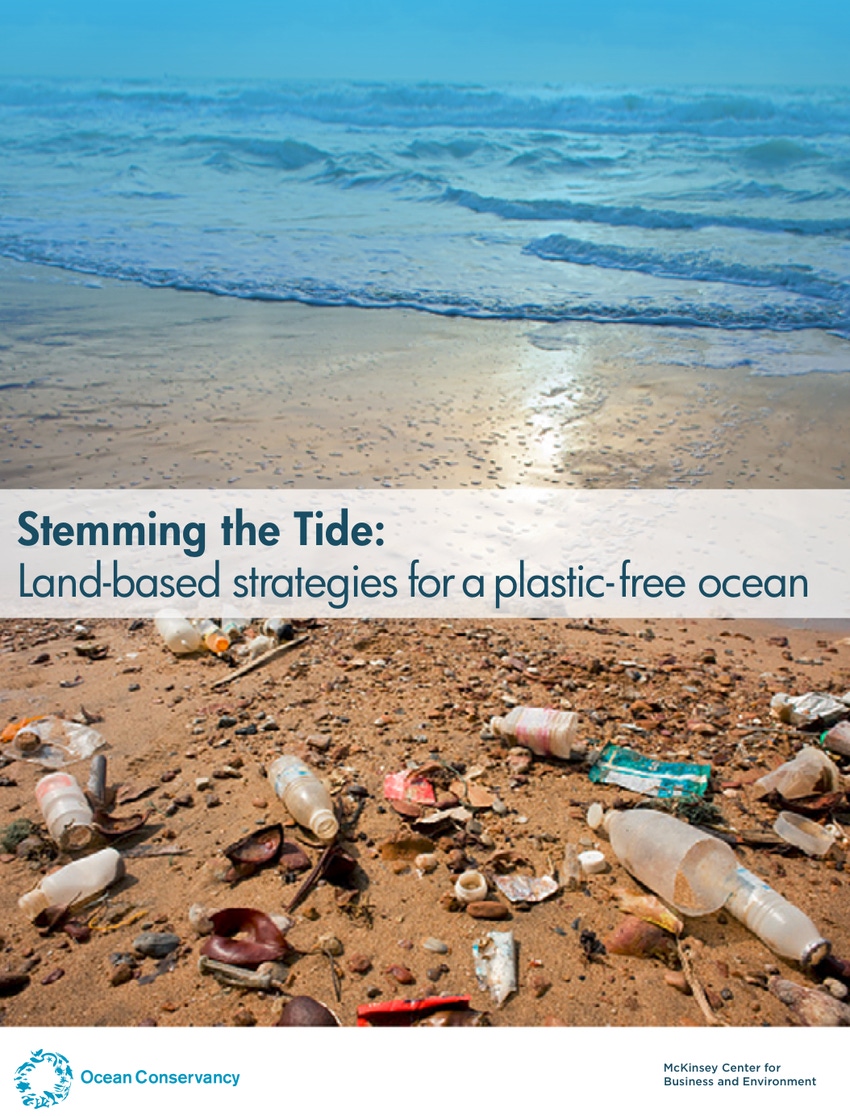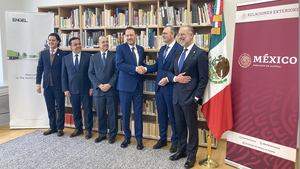Top 5 issues in plastics and packaging: The ACC responds
American Chemistry Council (Washington, D.C.) tackles ocean debris, mixed materials and other major concerns that permeate today’s plastics and packaging discussions inside and outside the industry.
April 18, 2018

Positioned figuratively at the center of the plastics industry, Washington, D.C.-based American Chemistry Council’s stated mission is to “solve some of the biggest challenges facing our nation and our world.”
After PlasticsToday asked the ACC to address the major issues in plastics packaging today, the following was submitted by Steve Russell, vp of ACC’s Plastics Division.
1. Some people put the blame for ocean debris squarely on plastics. How does ACC respond to this criticism?
Russell: We all want clean, healthy oceans. And because plastic is a large component of waste streams that leak into the ocean, those in the plastic supply chain have a role to play in delivering solutions. Data shows most ocean pollution comes from poorly managed municipal solid waste—which includes a range of material, not just plastic—from rapidly emerging economies that have yet to invest in waste management infrastructure. So for a truly clean ocean, the solutions implemented must consider what types of items are reaching the ocean, not just the material with which they’re made.
The use of plastics in emerging economies indicates a growing middle class with increased access to nutritious foods in sanitary packaging, personal care products, connectivity, transportation, and jobs. However, in these regions, the rise in access to consumer goods has outpaced the infrastructure needed to manage post-use materials of all kinds.
Without that infrastructure, trash—much of it plastics—ends up in rivers, on streets and sidewalks, and in our oceans. Many experts who have studied ocean plastics have determined that the most certain way to stop trash from getting into our oceans is to invest in infrastructure solutions that capture post-use resources and convert them into valuable products. Several types of technologies are enabling infrastructure to be designed—and materials to be used—with greater circularity (more about that below).
2. Given that a lot of plastics are getting into our oceans what is industry doing to address the problem?
Russell: Plastics makers across the globe are actively working to keep plastics out of our oceans. In 2011, ACC worked with our association colleagues to launch the Global Declaration—a program to engage the world’s plastics associations in delivering tangible solutions. Today, 75 associations from 40 countries have signed the Global Declaration and are tracking and publicly reporting projects in six areas. These include education, research, public policy, sharing best practices, plastics recycling/recovery, and plastic pellet containment. The number of projects reported by declaration signatories has grown to 355 and more than tripled since inception.
 We’ve learned that one of the most important ways we can contribute is to partner with organizations that offer critical expertise in ocean sciences and conservation, investment and infrastructure development. For example, ACC is a member of Ocean Conservancy’s Trash Free Seas Alliance® (TFSA), which is working on cross-sector innovations to prevent trash from reaching waterways. TFSA’s report Stemming the Tide (2015) identified ways to stop the flow of plastics into the ocean by growing waste management systems in countries where most plastics leakage occurs.
We’ve learned that one of the most important ways we can contribute is to partner with organizations that offer critical expertise in ocean sciences and conservation, investment and infrastructure development. For example, ACC is a member of Ocean Conservancy’s Trash Free Seas Alliance® (TFSA), which is working on cross-sector innovations to prevent trash from reaching waterways. TFSA’s report Stemming the Tide (2015) identified ways to stop the flow of plastics into the ocean by growing waste management systems in countries where most plastics leakage occurs.
Plastic makers are among major consumer brands that are working with the Closed Loop Partners to create a new fund (called Closed Loop Ocean (CLO) to prove a financing model for waste management. CLO is seeking funding commitments totaling $150 million to help finance infrastructure that advances the recovery and circularity of material use in countries with high levels of ocean bound waste. Plans call for funding projects as early as next year.
EastPack 2018 held June 12-14 at the Jacob K. Javits Convention Center in New York City features the latest in manufacturing and automation, a dedicated 3D Printing Zone, hundreds of exhibitors and a jam-packed 3-day packaging conference. For more information, visit the EastPack website. |
Next: Single-use plastics, mixed materials and the circular cconomy
3. Single-use plastics are the focus of a lot of attention these days. Some have proposed bans or taxes. Are there betters solutions?
Russell: Yes, there are better solutions, and many of them are underway or in practice right now. Some of these, we can all take part in, such as only taking a straw when you need one, bringing a reusable bag or bottle with you when you can, and remembering to recycle every day.
But it seems to us that attacking the broad category of “single use” plastics is over-reach. Certain plastic products are specifically designed to be used once (or for a short time) to help promote health and sanitary conditions (think bandages, contacts, personal hygiene). Another category—plastic food packaging—helps keep our food clean and safe, and extends freshness. And because plastic is both strong and lightweight—it helps conserve resources and reduce packaging waste. Plastics help us ship more product with less packaging material than many alternatives, and plastic packaging cuts down on transportation fuel use, greenhouse gas emissions, and waste.
If we replaced plastics with alternatives, as some have suggested, we’d lose these important benefits. A 2016 study by Trucost, Plastics and Sustainability, found that replacing plastic with alternatives in packaging and consumer products could raise environmental costs nearly fourfold. Another study showed that replacing plastic packaging with other materials would increase the amount of packaging generated in the United States by 55 million tons annually, and would increase energy use and greenhouse gas emissions by 82% and 130%, respectively. So banning and replacing plastics even in “single-use” applications clearly isn’t the answer.
Instead, we believe people should be able to enjoy the economic and environmental benefits of plastic by dramatically accelerating the reuse, recycling and recovery of post-use plastics. Work underway today will allow us to improve sortation and convert more used plastics into a range of valuable outputs that can be used as fuels and feedstocks for new manufacturing.
4. Are mixed and multi-material plastics still generally viewed as unrecyclable and is anything being done about that?
Russell: There’s a lot of innovation taking place in this area. ACC’s Plastics Division is leading an industry collaborative on to recover more flexible film packaging, particularly multi-material pouches. The collaborative calls itself Materials Recovery for the Future (MRFF), and its latest findings show that automated sorting technologies in use today can be optimized to capture flexible plastic packaging. MRFF is hopeful this will lead to the creation of a new stream of recovered materials (e.g.., multi-layer packaging) while reducing contamination in other streams. Other developments, such as solvents (e.g., PureCycle Technologies and CreaSolv), additives and compatibilizers (e.g., RETAIN), could yield additional options for recovering and repurposing mixed plastics.
 One of the most exciting developments underway today is recycling plastics by breaking them down into their basic molecules. This emerging family of technologies can be configured to accept a range of inputs, from pure resins (e.g., PS, PE, PP, PET) to mixed plastics and can produce a variety of outputs, including fuels for transportation, waxes, lubricants, monomers for new virgin plastics, and other basic chemicals for manufacturing. This collection of outputs can be used in countless markets.
One of the most exciting developments underway today is recycling plastics by breaking them down into their basic molecules. This emerging family of technologies can be configured to accept a range of inputs, from pure resins (e.g., PS, PE, PP, PET) to mixed plastics and can produce a variety of outputs, including fuels for transportation, waxes, lubricants, monomers for new virgin plastics, and other basic chemicals for manufacturing. This collection of outputs can be used in countless markets.
Policymakers are recognizing the tremendous potential of these technologies. In the past year, legislatures in Florida, Wisconsin and Georgia have updated their regulations to ensure that their regulations appropriately classify these technologies. Lawmakers are excited about the economic and environmental benefits of diverting additional types of plastics—including multi-material plastics—from landfill and instead converting them into useful new products. These technologies offer enormous potential in the shift toward a more circular economy.
5. Are plastics at a disadvantage in a circular economy?
Russell: The goal of implementing a circular economy is to optimize a full range of environmental and societal outcomes, and no material is better suited to meet these challenges than plastics. To be clear, we fully expect plastics to continue to excel in a circular economy.
Plastics are unique in their ability to help us do more with less, which includes everything from extending the freshness of healthy foods to driving further on a gallon of gas. And versatile plastics are enabling engineers to design out waste and inefficiency while extending recycling and other conversion options for post-use packaging and consumer products.
America’s plastics makers embrace the pursuit of a more circular economy guided by life cycle analysis to help ensure that resources are conserved, waste is reduced, recycling rates are improved, more products are reused, and the value of resources and materials is maximized.
While plastics are already an essential contributor to the circular economy, we recognize more must be done to increase the re-use, recycling and recovery of plastics. Much of our work involves collaborating with innovators to develop new products designed for recycling, and new technologies that advance recovery, including some that break down discarded plastics into their basic chemical building blocks, extending the life and the value of these molecules as raw materials that can be manufactured into entirely new products.
We believe building the infrastructure to allow us treat used plastics as valuable economic resources for new products will help usher in a new level of circularity, keep plastics out of our oceans, and enable us to use these valuable materials to further improve our global standard of living while reducing our environmental footprint.
For more on this issue, see Toward a broader view of the New Plastics Economy, published May 2017.
 Steve Russell is vice president of the American Chemistry Council’s Plastics Division, the industry’s source for solutions-oriented programs, scientific research, and public outreach initiatives for the plastics industry—with a particular focus on sustainability, recycling, recovery and marine debris.
Steve Russell is vice president of the American Chemistry Council’s Plastics Division, the industry’s source for solutions-oriented programs, scientific research, and public outreach initiatives for the plastics industry—with a particular focus on sustainability, recycling, recovery and marine debris.
About the Author(s)
You May Also Like


